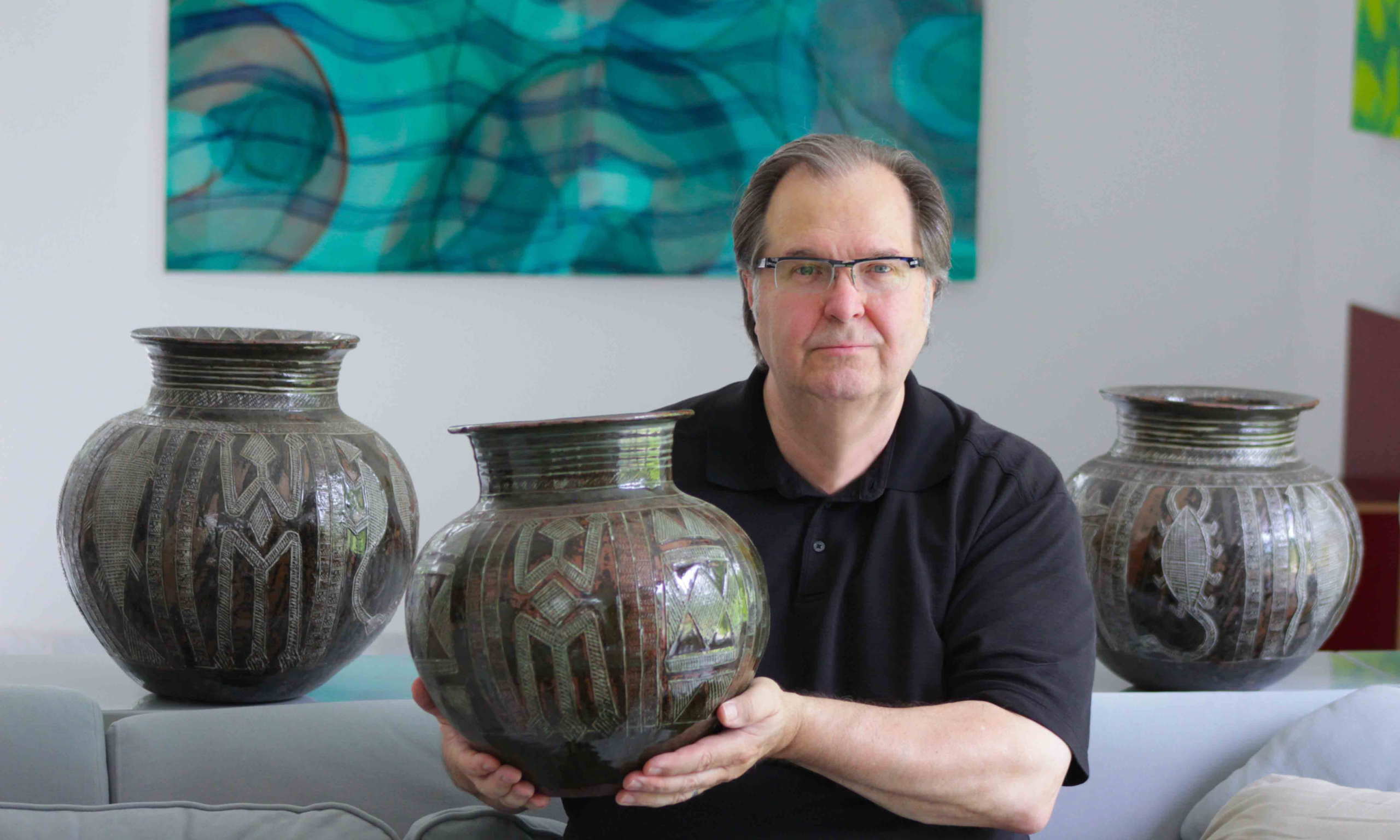John Driscoll, with a pot by Ladi Kwali
Photo: Emily Driscoll
When the American paintings dealer and Hudson River School painter John P. Driscoll died of Covid-19 last year aged 70, he left behind a huge collection of studio ceramics—Driscoll, the owner of Babcock Galleries in New York, had been about to retire and cataloguing these pots was to be his retirement project.
Instead, Ben Williams, Phillips' international ceramics consultant, and Marijke Varrall-Jones, the director of Maak Contemporary Ceramics, have collaborated to catalogue and sell the huge collection of over 1,600 items. In a sale called The Art of Fire: Selections from the Collection of Dr. John P Driscoll, Phillips (in association with Maak) will offer 163 of the more valuable lots in London on 10 November. Maak will present sales of further selections from the collection over the course of 2022, starting in spring.
Driscoll started collecting studio ceramics in the 1970s and never stopped—according to Williams, he bought some pieces from Phillips just two weeks before he died last year.
Hans Coper's works including the monumental Writhlington School pot, exchanged for a goat called Jennea (second left)
Courtesy of Phillips
"John recognised the importance of provenance, and the history and stories that were associated with paintings, and he applied that to his collecting pots in a way that nobody else really did," Williams says. "Most people who are collecting pots are just lucky on an aesthetic basis, but John added this layer of academic scholarly intent to his collecting." He intended to build a study collection and, Williams says, "I think long term, he was potentially going to build a study centre" to accomodate the works.
Marijke Varrall-Jones, the director of Maak Contemporary Ceramics, says: “With Bernard Leach recognised as 'where it all began' the historical context resonated with John's academic inclination, allowing him to explore the aesthetic and historical connections of British studio ceramics to Asian and European traditions."
Driscoll was particularly in the strong Japanese and Danish influences in British studio pottery and the close relationships between the artists who produced these pots, particularly the master-pupil relationships. The collection centres on perhaps the Holy Trinity of studio ceramicists: Bernard Leach, Lucie Rie and Hans Coper. And it is the backstories, as much as the quality, of these piece that attracted Driscoll to them. As Williams says, "there is one piece that Lucie Rie carried with her, wrapped in clothes in her suitcase, when she fled from Vienna in 1938." Coper, too, was a German refugee (considered an enemy alien at the time) and became Rie's assistant. "With the catalogue, we're trying to show the connections between the artist—there are pots that Bernard Leach gave to Lucie Rie, for example," Williams adds.
A group of Lucy Rie ceramics included in the sale
Courtesy of Phillips
Another pot, a monumental stoneware example, was given by Hans Coper to Writhlington School in Radstock, Somerset, in exchange for a goat called Jennea in 1972. Williams explains: "Coper and Jane, his wife, moved to an old farm near Frome and Jane wanted to have some goats. She found out that one of the local schools had a farm unit and there were some kids available. She went along and asked if she could buy one of these kids and they said, 'no, we can't sell one too, but maybe we could swap one for a pot'. Even back in 1972, one of Hans's pots would have bought quite a lot of goats. But he made an absolutely enormous pot, perfect for a school, and inscribed it on the base: 1X1972 HC To Writhlington School. Thank you for Jennea the Goat." The 77cm high pot is now estimated at £80,000 to £120,000.
The sale also includes works by Hamada Shoji, James Tower, Elizabeth Fritsch, Gordon Baldwin, Ewen Henderson and Edmund de Waal, alongside Japanese, Nigerian and Danish ceramics. Highlights include a Bernard Leach slipware charger with a Tree of Life design (around 1924, estimate £15,000-£20,000), a Koike Shõko lidded Shell Vessel (around 1997, estimate £20,000-£30,000) and the Nigerian ceramicist Ladi Kwali's Airplane Water Pot (1962, estimate £6,000-£9,000).
On the broader market for studio pottery, Williams says: "There have been dedicated studio pottery sales at auction since the late 1970s, and there's always been a very strong collecting group in the UK and US. However, more recently, there's a lot of interest from Asia in certain artists' work, for example Lucie Rie and Hans Coper. Rie is really considered a Japanese artist in Japan, and she and Coper have become almost like a brand—they have a visibility among the super wealthy." That, he says, "has really moved the market on to a completely different level in the last 10 years. It's on fire now."

